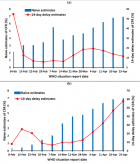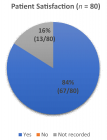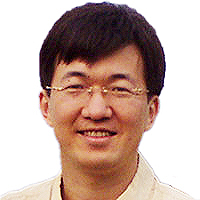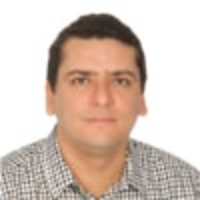Abstract
Research Article
eactive Oxygen Species Production from Hydroxamic Acid and their Iron (III) Complexes against Staphylococcus aureus and Escherichia coli
Ibrahima Sory Sow*, Naïma El Manssouri and Dong Yang
Published: 15 May, 2024 | Volume 9 - Issue 1 | Pages: 017-020
The N-hydroxydodecanamide (HA12) and its complexes tri-hydroxamato-iron(III) and di-hydroxamto-iron(III) chloride (HA8Fe3 and HA12Fe3Cl, respectively) showed antibacterial and antimycobacterial activities. The proteomic analysis demonstrated that the targets of Hydroxamic Acid (HA) and their complexes were involved in the biosynthesis of mycobacterial cell walls. The Reactive Oxygen Species (ROS) is one of the key elements to cause oxidative stress, damaging DNA, and cell membranes impaired during the procedure to kill bacteria. Here, the ROS production was determined to evaluate the compounds HA12, HA8Fe3, HA12Fe3Cl, and ZnCl2 against bacteria using 2’,7’-dichlorofluorescein diacetate (DCFDA) by spectrofluorometric analysis. The low fluorescence was observed using the compounds HA12, HA8Fe3, HA12Fe3Cl, and ZnCl2 treating the S. aureus and E. coli, indicating that the ROS production could not be observed using the compounds used at a dose higher than the Minimum Inhibitory Concentration (MIC). It was noted that the ROS determination could be performed with a concentration less than or equal to the MIC. This would enable the mechanism of action linked to the ROS production by HA and their metal complexes to be determined.
Read Full Article HTML DOI: 10.29328/journal.jcicm.1001048 Cite this Article Read Full Article PDF
Keywords:
Hydroxamic acid; Iron complexes; Reactive Oxygen Species (ROS)
References
- Khan S, P MR, Rizvi A, Alam MM, Rizvi M, Naseem I. ROS mediated antibacterial activity of photoilluminated riboflavin: A photodynamic mechanism against nosocomial infections. Toxicol Rep. 2019 Jan 9; 6:136-142. doi: 10.1016/j.toxrep.2019.01.003. PMID: 30671349; PMCID: PMC6330557.
- Kumar H, Gupta S, Siddiqui A, Kumar V. Advances in Design and Development of Inhibitors of Nitric Oxide Synthases, Curr. Enzym. Inhib. 2013; 9:117–141. https://doi.org/10.2174/1573408011309020005.
- Saban N, Bujak M. Hydroxyurea and hydroxamic acid derivatives as antitumor drugs. Cancer Chemother Pharmacol. 2009 Jul;64(2):213-21. doi: 10.1007/s00280-009-0991-z. Epub 2009 Apr 7. PMID: 19350240.
- Gupta SP, Sharma A. Hydroxamic acids: A unique family of chemicals with multiple biological activities, Springer-Verlag. 2013; 1–17.
- Bertrand S, Hélesbeux JJ, Larcher G, Duval O. Hydroxamate, a key pharmacophore exhibiting a wide range of biological activities. Mini Rev Med Chem. 2013 Jul;13(9):1311-26. doi: 10.2174/13895575113139990007. PMID: 23701657.
- Burkitt MJ, Raafat A. Nitric oxide generation from hydroxyurea: significance and implications for leukemogenesis in the management of myeloproliferative disorders. Blood. 2006 Mar 15;107(6):2219-22. doi: 10.1182/blood-2005-08-3429. Epub 2005 Nov 10. PMID: 16282342.
- Kim KM, Cho SS, Ki SH. Emerging roles of ferroptosis in liver pathophysiology. Arch Pharm Res. 2020 Oct;43(10):985-996. doi: 10.1007/s12272-020-01273-8. Epub 2020 Oct 20. PMID: 33079307.
- Lin LS, Song J, Song L, Ke K, Liu Y, Zhou Z, Shen Z, Li J, Yang Z, Tang W, Niu G, Yang HH, Chen X. Simultaneous Fenton-like Ion Delivery and Glutathione Depletion by MnO2-Based Nanoagent to Enhance Chemodynamic Therapy. Angew Chem Int Ed Engl. 2018 Apr 23;57(18):4902-4906. doi: 10.1002/anie.201712027. Epub 2018 Mar 23. PMID: 29488312.
- Dimapilis EAS, Hsu CS, Mendoza RMO, Lu MC. Zinc oxide nanoparticles for water disinfection, Sustain. Environ. Res. 2018; 28: 47–56. https://doi.org/10.1016/j.serj.2017.10.001.
- Huang J, Sommers EM, Kim-Shapiro DB, King SB. Horseradish peroxidase catalyzed nitric oxide formation from hydroxyurea. J Am Chem Soc. 2002 Apr 3;124(13):3473-80. doi: 10.1021/ja012271v. PMID: 11916434.
- Can Z, Keskin B, Üzer A, Apak R. Detection of nitric oxide radical and determination of its scavenging activity by antioxidants using spectrophotometric and spectrofluorometric methods. Talanta. 2022 Feb 1;238(Pt 1):122993. doi: 10.1016/j.talanta.2021.122993. Epub 2021 Oct 22. PMID: 34857326.
- Hassan AU, Sumrra SH, Imran M, Chohan ZH. New 3d multifunctional metal chelates of sulfonamide: Spectral, vibrational, molecular modeling, DFT, medicinal and in silico studies, J. Mol. Struct. 2022; 1254:132305. https://doi.org/10.1016/j.molstruc.2021.132305.
- Aderibigbe BA. Metal-Based Nanoparticles for the Treatment of Infectious Diseases. Molecules. 2017 Aug 18;22(8):1370. doi: 10.3390/molecules22081370. PMID: 28820471; PMCID: PMC6152252.
- Sow IS, Gelbcke M, Meyer F, Vandeput M, Marloye M, Basov S, Van Bael MJ, Berger G, Robeyns K, Hermans S, Yang D, Fontaine V, Dufrasne F. Synthesis and biological activity of iron(II), iron(III), nickel(II), copper(II) and zinc(II) complexes of aliphatic hydroxamic acids, J. Coord. Chem. 2023; 76:76–105. https://doi.org/10.1080/00958972.2023.2166407.
- Yang D, Zhang Y, Sow IS, Liang H, El Manssouri N, Gelbcke M, Dong L, Chen G, Dufrasne F, Fontaine V, Li R. Antimycobacterial Activities of Hydroxamic Acids and Their Iron(II/III), Nickel(II), Copper(II) and Zinc(II) Complexes. Microorganisms. 2023 Oct 23;11(10):2611. doi: 10.3390/microorganisms11102611. PMID: 37894269; PMCID: PMC10609363.
- Zhang XF, Shen W, Gurunathan S. Biologically Synthesized Gold Nanoparticles Ameliorate Cold and Heat Stress-Induced Oxidative Stress in Escherichia coli. Molecules. 2016 Jun 4;21(6):731. doi: 10.3390/molecules21060731. PMID: 27271586; PMCID: PMC6273942.
- Rajneesh, Pathak J, Chatterjee A, Singh SP, Sinha RP. Detection of Reactive Oxygen Species (ROS) in Cyanobacteria Using the Oxidant-sensing Probe 2',7'-Dichlorodihydrofluorescein Diacetate (DCFH-DA). Bio Protoc. 2017 Sep 5;7(17):e2545. doi: 10.21769/BioProtoc.2545. PMID: 34541194; PMCID: PMC8413551.
Figures:

Figure 1

Figure 2

Figure 3

Figure 4

Figure 5
Similar Articles
-
eactive Oxygen Species Production from Hydroxamic Acid and their Iron (III) Complexes against Staphylococcus aureus and Escherichia coliIbrahima Sory Sow*, Naïma El Manssouri, Dong Yang. eactive Oxygen Species Production from Hydroxamic Acid and their Iron (III) Complexes against Staphylococcus aureus and Escherichia coli. . 2024 doi: 10.29328/journal.jcicm.1001048; 9: 017-020
Recently Viewed
-
Success, Survival and Prognostic Factors in Implant Prosthesis: Experimental StudyEpifania Ettore*, Pietrantonio Maria, Christian Nunziata, Ausiello Pietro. Success, Survival and Prognostic Factors in Implant Prosthesis: Experimental Study. J Oral Health Craniofac Sci. 2023: doi: 10.29328/journal.johcs.1001045; 8: 024-028
-
Bleeding from Varices: Still a Heavy Burden in Patients with CirrhosisAmitrano L*, Guardascione MA, Saviano S, Martino A, Lombardi G. Bleeding from Varices: Still a Heavy Burden in Patients with Cirrhosis. Ann Clin Gastroenterol Hepatol. 2023: doi: 10.29328/journal.acgh.1001043; 7: 035-037
-
Prevention of workplace violence in ED nursing using the implementation of an educational program and a new reporting toolMaziad Aladwan*,Ekbal Dalahmeh. Prevention of workplace violence in ED nursing using the implementation of an educational program and a new reporting tool. Clin J Nurs Care Pract. 2022: doi: 10.29328/journal.cjncp.1001039; 6: 001-008
-
Which women uses social Internet networks during pregnancy?Sylvie Viaux-Savelon*,Catherine Fouillet,Nicolas Bodeau,Jacky Nizard. Which women uses social Internet networks during pregnancy?. Clin J Obstet Gynecol. 2021: doi: 10.29328/journal.cjog.1001082; 4: 025-032
-
The Role of Mitochondria in Chronic Wound Healing (Mitotherapy): Signaling and Therapeutic ImplicationsSeyedeh Sara Azadeh*,Hoda Keshmiri Neghab. The Role of Mitochondria in Chronic Wound Healing (Mitotherapy): Signaling and Therapeutic Implications. Arch Biotechnol Biomed. 2025: doi: 10.29328/journal.abb.1001043; 9: 001-009
Most Viewed
-
Evaluation of Biostimulants Based on Recovered Protein Hydrolysates from Animal By-products as Plant Growth EnhancersH Pérez-Aguilar*, M Lacruz-Asaro, F Arán-Ais. Evaluation of Biostimulants Based on Recovered Protein Hydrolysates from Animal By-products as Plant Growth Enhancers. J Plant Sci Phytopathol. 2023 doi: 10.29328/journal.jpsp.1001104; 7: 042-047
-
Sinonasal Myxoma Extending into the Orbit in a 4-Year Old: A Case PresentationJulian A Purrinos*, Ramzi Younis. Sinonasal Myxoma Extending into the Orbit in a 4-Year Old: A Case Presentation. Arch Case Rep. 2024 doi: 10.29328/journal.acr.1001099; 8: 075-077
-
Feasibility study of magnetic sensing for detecting single-neuron action potentialsDenis Tonini,Kai Wu,Renata Saha,Jian-Ping Wang*. Feasibility study of magnetic sensing for detecting single-neuron action potentials. Ann Biomed Sci Eng. 2022 doi: 10.29328/journal.abse.1001018; 6: 019-029
-
Pediatric Dysgerminoma: Unveiling a Rare Ovarian TumorFaten Limaiem*, Khalil Saffar, Ahmed Halouani. Pediatric Dysgerminoma: Unveiling a Rare Ovarian Tumor. Arch Case Rep. 2024 doi: 10.29328/journal.acr.1001087; 8: 010-013
-
Physical activity can change the physiological and psychological circumstances during COVID-19 pandemic: A narrative reviewKhashayar Maroufi*. Physical activity can change the physiological and psychological circumstances during COVID-19 pandemic: A narrative review. J Sports Med Ther. 2021 doi: 10.29328/journal.jsmt.1001051; 6: 001-007

HSPI: We're glad you're here. Please click "create a new Query" if you are a new visitor to our website and need further information from us.
If you are already a member of our network and need to keep track of any developments regarding a question you have already submitted, click "take me to my Query."
















































































































































